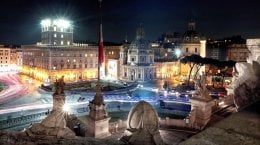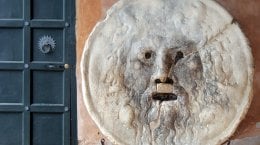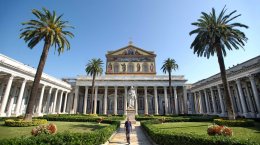Official Reseller Rome and Vatican – Jubilee 2025
Markets of Trajan
The Markets of Trajan represent an extensive complex of Roman buildings in the city of Rome, on the slopes of the Quirinal hill. Since 2007 they have host the “Museo dei Fori Imperiali”

History and architecture of the Markets of Trajan.
The Markets of Trajan of Rome are an architectural complex rich in history, located on the slopes of the Quirinal Hill.
Built at the same time as the Forum of Trajan at the beginning of the 2nd century, they originally extended beyond the limits of the current archaeological area, and were in ancient times the nucleus of administrative activities linked to the Imperial Forums.
Furthermore, the presence of warehouses and shops also suggests a possible secondary use in commercial activities, possibly carried out in the outermost areas of the complex.
Going back to the Kingdom of Trajan, it is believed that the project of the Markets should be attributed to its architect, Apollodorus of Damascus, even if there is the possibility that the construction works actually started under the reign of Domitian.
Rediscovered between 1926 and 1934, the architectural complex of the Markets of Trajan is characterized by buildings that are articulated on six different levels of construction, which support the cut made on the slopes of the hill, and from a lower part, of a semicircular nature, which looks towards the Forum of Trajan. The construction took place mainly through the use of the opus latericium technique, which involves the use of concrete with a facing in brick.
The structure was effectively designed to be able to consistently exploit the spaces available near the hill; the result is the presence of environments of different nature and form, obtained on the various levels that make up the architecture of the market, passing from the lower area of a semicircular shape, to the upper one of a straight line. In between, staircases and internal connections of various kinds connect the different environments between the various levels of construction on which they are articulated. These links also served as dividers between one space and another, dividing this complex system of chambers based on the function for which they were used.
Overview of the architectural structure of the Trafficking Markets
The main rooms that make up the architectural complex of the Mercati di Traiano are the following:
– Great Hall
Divided over three floors, it overlooks the Via Biberatica in the valley and on the ground floor of the Market Hall. On the upper floor, instead, it leaves room for a series of uncovered corridors which in turn open onto a third floor, with intercommunicating spaces that can be reached by the staircase leading to the upper floors.
The Great Hall is characterized by the presence of six cross vaults that outline the roof, which extends through a series of arches up to the open corridors, divided by cemented pillars.
– Central body
As the name suggests, this is the building more centrally located than the others, rising between the Via Biberatica downstream and the area of the Giardino delle Milizie and Via della Torre upstream. It is also characterized by the presence of three floors of rooms and a series of tabernae that overlook the Via Biberatica.
– Via Biberatica
It is the way that connects the upper part of the Markets with the lower zone of a hemicyclic form, following the progress of the structure. It sees the main rooms of the Great Hall and the Small Hemicycle, which can be traced in shape and size, to the ancient Roman tabernae.
– Great Hemicycle
It is the part that remains closest to the Forum of Trajan. For this reason, it was built with fine materials, using brick masonry and a series of elegant decorations along the facade.
This is also divided on three different floors; it presents a series of eleven rooms of modest size and depth on the ground floor at the level of the Forum, which are articulated along the whole structure, while it is characterized by a semi-annular corridor on the mezzanine floor, covered by barrel vaults rebuilt on the basis of the original ones. On the third floor there is an outdoor terrace, probably used as a passage area, characterized by a series of rooms that open onto Via Biberatica.
– Small Hemicycle
By means of the stairs located north of the Great Hemicycle, it is possible to reach the Little Hemicycle: a structure arranged, like the others, on three levels of construction, which opens onto a vast semicircular room, covered by a semi-dome.
– Headboard Classrooms
These are two large semicircular rooms located near the two ends of the Great Hemicycle. Of the two, the northern one is larger, while both are characterized by the presence of a semi-dome and a central entrance.
– Garden of the Militias
In the upper part of the buildings of the Great Hall and of the Central Building a path called “Via della Torre” is outlined; this path leads to the highest point of the Markets of Trajan and the Torre delle Milizie, offering an overview of the entire complex.
In this area the architectural interventions carried out in the Middle Ages, which have transformed most of the present structures, starting from the Tower, are particularly evident.
The Markets of Trajan and the Museum of the Imperial Forums
Today, in a strongly evolving cultural context, the Markets of Trajan are home to the Museum of Imperial Forums, that was established place there in 2007, after an intensive phase of restoration and conservation work that saw the complex of Markets as the protagonist between 2005 and 2007.
From 1985 until today, the archaeological area has found over 40,000 fragments and architectural artifacts of various nature and size, carefully cataloged and documented, giving the Markets an invaluable forensic architectural heritage.
The Museum, part of the system of the civic museums of Roma Capitale, proposes the visit of the Imperial Forums, enhancing the architecture and the sculptural decorations. Moreover, it boasts the presence of various reconstructions, carried out thanks to the use of some historical architectural findings that were useful to give an even more complete vision of the buildings of the Forums and of its scenarios to the visitors.
The intention of the museum, in fact, is not only to exhibit singular fragments and isolated historical artefacts, but also to materially recompose the architectural and sculptural structures of the Forums, also using the most modern technologies.
The aim is to offer the visitor an in-depth knowledge of the splendid architectural past of the Imperial Forums, as well as a unique contemplative experience.
The Museo dei Fori Imperiali is located on the upper floors of the Markets of Trajan. It offers an exciting tour that starts from the Great Hall, and then continues upstairs in the Central Corps, in the areas dedicated to the Forum of Caesar and the Forum of Augustus, with particular attention also to the beautiful Temple of Mars Ultor, that was formerly placed inside it.
As the market hosts the museum, in the same way the museum offers a series of itineraries that also propose a reflection on the profound relationship between history and architecture, between the city and its neighborhoods.
Timetables and useful directions to visit the Trajan Markets
The Mercati di Traiano complex and the Museo dei Fori Imperiali are open every day from 09.30 a.m. until 7.30 p.m., except for December 24 and 31, opening at 09.30 a.m. – 2.00 p.m. The complex is closed to the public on January 1, May 1 and December 25. The ticket office closes one hour before the indicated time.
It is possible to reach the Mercati di Traiano both by car and by public transport using Rome ATAC services. To calculate the relative journey, the address of the archaeological complex is Via Quattro Novembre, 94, 00187 Rome.
Open every day from 09.30 a.m. to 7.30 p.m., December 24 and 31: from 09.30 a.m. to 2.00 p.m.;
Last entry is 1 hour before closing time
Closed
January 1; May 1, December 25
Check the stops of the Open Top Bus Vatican & Rome on the map in order to find the closest stop to the attraction you are interested in visiting;
Alternatively, consult https://www.google.com/maps for information on public transport.
Remember: with Omnia 72h you have access to all means of public transport of Rome.
Colosseum, Mamertine Prison, Roman Forums




